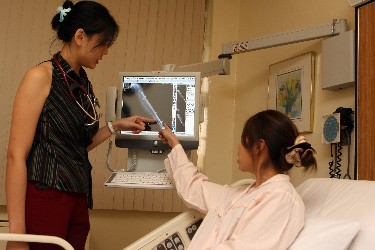Singapore hospital boosts bedside care

SINGAPORE--Singapore's oldest hospital unveiled this week a touchscreen system that provides access to integrated information right at the patients' beds.
Singapore General Hospital, an institution under the SingHealth healthcare cluster, said in a statement Tuesday that its new Patient Bedside Terminal benefits both clinicians and patients.
 Doctors and nurses can retrieve and display patients' medical records and digital radiology images at their bedside. |
The system enables doctors and nurses to retrieve and display medical records and digital radiology images at the patients' bedside, while patients can use it to access entertainment and Internet services, or speak to nurses on duty via the video-call feature.
The Patient Bedside Terminal is part of the SGH Digital Ward project, which encompasses the deployment of wireless technologies to make it easier and faster for healthcare professionals to capture and access clinical information.
According to SingHealth, the terminal will be trialed at two other hospitals--KK Women's and Children's Hospital and Changi General Hospital--by the end of the year.
SingHealth's iTAG (Innovative Technology Application Group) team, which implemented the project, will modify the system and customize applications to meet each hospital's needs.
For example, terminal units at KK Hospital may include a feature allowing virtual ward visits, useful for parents who cannot be with their young children during the doctors' daily morning ward rounds. This feature enables parents to dial in using 3G mobile phones or through Webcam-enabled computers, and get updates on their children's condition without having to make a trip to the hospital.
At Changi General Hospital, the Patient Bedside Terminal may include a module that allows patients to access educational materials on their medical conditions and treatment options.
The Singapore government unveiled Thursday a funding boost of S$3 million (US$2 million) in a move to encourage more innovative healthcare IT applications.